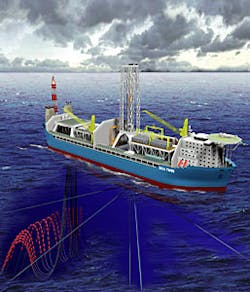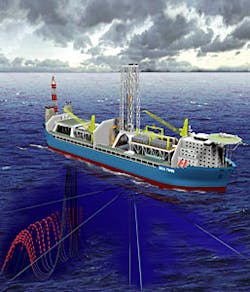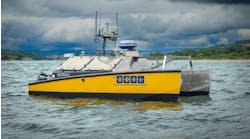Adding drilling to production vessels
Even without using its storage capability, theSea Twin is claimed as an interesting floating drilling and production unit for the Gulf of Mexico.LMG Marin's Sea Twin drilling and production ship is suitable for use in the deep waters of the Gulf of Mexico, as well as other areas of the world. Even though the ship-shape vessel would not be allowed to use its storage capability because of the current regulatory situation in the US, as a floating drilling and production unit (FDPU) it would provide operators with the great benefits of having drilling and well intervention facilities permanently available.
It is high time the oil industry as a whole realized the value of having a drilling capability on its floaters, says managing director Geir Kjersem. As recent reports have made clear, a lot of oil and gas is being left in the ground, which with state-of-the-art reservoir management and downhole technology could be recovered. In the case of fields produced by floaters, this situation largely arises because of the cost and inconvenience of having to bring in a mobile rig.
It may be a false economy to decide the capital investment to be made in producing a field on the basis of net present value, which is weighted towards up-front investments and takes no account of what potential may still remain to be realized in 10-20 years' time, Kjersem says.
Life-of-field view
Instead, he would like to see more companies taking the life-of-field perspective adopted by Norsk Hydro, which has put drilling facilities on the semisubmersible production platforms it has installed on the Njord and Visund Fields in the Norwegian sector. He knows of few other examples other than Amoco's Luihua Field in China, which also features a semisubmersible with drilling capabilities.For drilling and production duty in the US Gulf, Kjersem proposes the smallest of the threeSea Twin versions so far developed, the Sea Twin 210 (the figure refers to the vessel's length). It has a deck area of about 11,000 sq meters and payload capacity in excess of 32,000 tons for drilling and production equipment. It can accommodate 32 risers and is capable of producing 150-180,000 b/d of oil. It can operate in water depths down to about 3,000 meters.
The vessel is moored and uses the mooring winches to move about over the subsea wells, just as a drilling and production semisubmersible does. A version of the hull has been developed for the easy disconnect of risers in the case of vessels operating in hurricane-prone areas.
Even though its storage potential is not being used, theSea Twin offers a number of advantages compared with a semisubmersible. It has a large payload capacity, an extensive deck area, and a favorable building cost, being easier to build and therefore within the capabilities of a greater number of shipyards. The cost of building a Sea Twin 210 as an FDPU would be approximately $270 million, according to Kjersem, a figure that excludes loose drilling equipment and production equipment.
In recent years, some concepts have been developed for conventional turreted production ships with drilling facilities. But theSea Twin would also cost less than these because it has no turret. The turret is a complex, technically demanding and expensive piece of equipment, even on ships intended only for production. If drilling facilities were to be taken on board, LMG Marin decided, the best way was to lose the turret.
"We adopted the same safety philosophy as on fixed platforms," says Kjersem. "And therefore we segregated the drilling and production areas."
Twin bows
As an alternative to the turret, which allows the conventional production ship to weathervane through 360°, the Sea Twin has bows at either end. Therefore, the vessel can head the seas in any direction by weathervaning through only 180°, in effect 90° to either side of its centerline.The vessel rotates around its midships, which is where the drilling derrick and moonpool are placed. The production facilities and moonpool for the production risers are at one end, separated from the drilling area by a firewall. The living quarters are at the other end, also separated by a firewall. Between the living quarters and the derrick are the drillpipe racks.
The ship is moored, as it would be immensely expensive to perform stationkeeping with a dynamic positioning system for a production operation lasting for years. However, it has DP capability and this is used to assist in weathervaning.
Rotation takes place around the drillstring, the mooring lines being attached to rotatable fairleads in the midships area of the hull. There are 8-12 lines, but their placement is somewhat different from that in a conventional mooring system, as there are no lines in the area of the production risers.
The minimum distance between the mooring line attachments and the production risers is 40 meters, which is sufficient to ensure that there is no collision between the lines and the risers during weathervaning, Kjersem says. The risers and their attachments have also been designed to withstand torsion and the dynamic motions during operations.
Solutions have been found to the problems involved in enabling a moored production ship to weathervane, Kjersem says, and where necessary these have been included in the patents applied for theSea Twin concept.
Copyright 1999 Oil & Gas Journal. All Rights Reserved.




